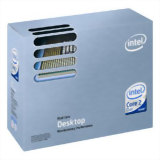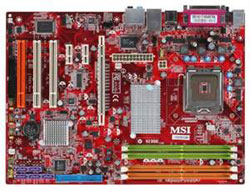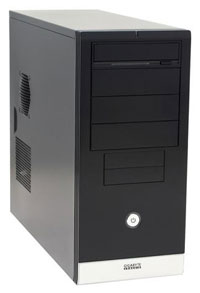Baseline Intel Midrange Platform
As we mentioned already, Intel has without a doubt regained the performance crown when it comes to CPUs. For pure number crunching, 3D rendering, video encoding, and other CPU intensive tasks, Intel's Core 2 Duo processors almost invariably outperform AMD's Athlon X2 offerings. They do cost a bit more, but they also run cooler and overclock better. All other things being equal, we currently recommend Intel configurations over AMD configurations, although there are a few advantages the AMD platform still holds. Most of our components remain the same as the previous page, with the exception of the motherboard and processor.
 |
Again, we feel there is little reason to consider anything other than a dual core processor these days. For Intel platforms, you really don't get much choice unless you want to go with an old Pentium 4 processor, as the single core versions of the Core 2 architecture won't be released for several more months. As with the AMD system, we selected the lowest end processor for our baseline configuration. The Core 2 Duo E6300 comes clocked at 1.86 GHz and features 2MB of shared L2 cache. Overclocking attempts with the E6300 have been extremely successful, and the limiting factor is almost always the motherboard and/or memory unless you spend money on higher end components. The default 7X CPU multiplier means that reaching a CPU clock speed of 3 GHz (something that is possible with most Core 2 Duo chips) will require a front side bus speed of 428 MHz, not to mention memory that can also run at DDR2-856 or higher. Unfortunately, motherboards that will support such bus speeds cost more money.
 |
Unlike the AMD platform, picking an ideal motherboard for socket 775 is a bit trickier. We could always go with one of the cheap ASRock motherboards that we have reviewed recently, but most of those are a bit quirky and none of them overclock very well. For a midrange system, we really don't want to skimp on the motherboard at all, and the most reasonable choice is to get a board that uses the P965 chipset. The MSI P965 Neo-F gets our recommendation, as it is currently the cheapest P965 motherboard available and it still performs reasonably well. It won't overclock as high as many of the other offerings on the market, but it is a very solid offering overall. The ECS P965 P965T-A and Foxconn P9657AA-8KS2H are similar in terms of stability, features, and overclocking support -- better in some areas, and worse in others. After our talk above about how high the E6300 can overclock, we need to make it absolutely clear that you'll never come near those overclock levels with any of the three motherboards we've just mentioned. Plan on flashing the BIOS as well, as the vast majority of P965 motherboards have had some serious memory compatibility issues with the initial BIOS revisions. Assuming you can live with those limitations, at $100 the board is still a reasonable option, but you do get what you pay for.
We've covered the memory and video card choices already, so let's move on to the storage and other options. The choice of DVD-RW drives is pretty simple: get whatever it is cheapest. Some of the DVD burners are more compatible with a wider range of media, but overall the NEC ND-3550A works very well and at $30 there's little reason to get anything else. If prices change in the near future, LG, BenQ, Pioneer, and LiteOn are reasonable alternatives.
Choosing a hard drive takes a bit more effort. Most of the major SATA drives are worth consideration, so it comes down to a matter of price and capacity, but warranty and noise levels also play a role. The Samsung 3.0Gbps 250GB SpinPoint P offers an extremely low price/GB and it is also the quietest hard drive presently available. It is not the fastest drive available, so if you do a lot of hard disk intensive tasks you might prefer something else, but 250GB of storage and a quiet drive to go with our silent GPU seems to make sense as a baseline recommendation. Western Digital, Seagate, Maxtor (who is now owned by Seagate), and Hitachi all offer varying features, prices, warranties, etc. If you are less concerned about noise levels, the Western Digital 250 GB SE16 is a close second place that only costs a couple dollars more.
 |
We won't worry too much about the keyboard and mouse other than to say get whatever you like best. Most of us like Microsoft and Logitech input devices, but if you have a personal preference stick with that. For the case, we wanted something that was reasonably easy to work with, reasonably quiet, and not too expensive. The Gigabyte GZ-X1 fits these requirements and it also includes a 350W power supply. The power supply may not be the best for extreme overclocking or running a high-end configuration, but the baseline selections that we've chosen will be hard-pressed to get over ~250W of total power draw. If you don't like the way the Gigabyte case looks, as with the keyboard feel free to get something that you do like. For the power supply, if you want something better than a bundled PSU, we would recommend looking at Fotron Source (FSP Group/Sparkle), Enermax, OCZ, and SeaSonic as quality upgrades, although most aftermarket PSUs that are substantially better than the bundled 350W PSU are likely to cost quite a bit of money.
We have covered all of the baseline components with the exception of the operating system and the display. We will save discussion of the LCD choices for a separate section. As for the operating system, Windows XP Media Center Edition 2005 falls somewhere between XP Home and XP Professional, both in terms of price and features. For home networks, we definitely prefer XP Professional over XP Home, but MCE 2005 includes most of the features we like and it only costs about $10 more than XP Home. In addition, users who add a TV tuner also get the MCE interface, which does a very good job at providing PVR functionality.













49 Comments
View All Comments
JarredWalton - Tuesday, October 3, 2006 - link
For a moderate system, I like PSU fan + front fan + rear fan (all 120mm if possible, with lower RPMs). More than two case fans gets to be overkill, and you could probably run a single 120mm rear case fan without problems.jonp - Thursday, September 28, 2006 - link
I think the E6400 base is 2.13GHz not 2.16Ghz.http://www.intel.com/products/processor/core2duo/s...">http://www.intel.com/products/processor/core2duo/s...
JarredWalton - Thursday, September 28, 2006 - link
It is. Did I mess that up somewhere? Ah: I had it right in the table but missed it in the text below. Sorry. It's been corrected now.jonp - Wednesday, September 27, 2006 - link
The MSI P965 Neo-F takes a beating by Newegg buyers:http://www.newegg.com/Product/Product.asp?Item=N82...">http://www.newegg.com/Product/Product.asp?Item=N82...
The trouble folks are having with the MB make me wonder
if the choice should be rethought? Or at least, if you're thinking
about it, read the experiences folks are having so you are
prepared make the choice work for you.
Jon
JarredWalton - Wednesday, September 27, 2006 - link
The original BIOS adhered directly to Intel's specs so memory not capable of 1.8V at boot or over DDR2-800 JEDEC had issues. (Of course this happened on just about all of the P965 boards! P965 at launch was a joke - just ask Gary Key.) MSI is still working on updating the BIOS, but the current version now works fine with DDR2-800 or below 1GB modules. You did note that the system recommendation included 2x1GB of DDR2-667, right?Anyway, this is a base P965 board, and it has limited overclocking and other capabilities. Anyone buying it thinking they are going to get an awesome OC is nuts, and that's likely where the negative comments on Newegg come from. Buying higher-end RAM and putting it in a lower-end motherboard often results in problems. I have a lot of motherboards that won't POST at all with some OCZ DDR2-800 RAM that wan'ts 2.2V for 3-3-3 timings, or 1.8V for 5-5-5 timings.
How far can the MSI P965 go? I believe the current BIOS limit is 350 MHz, with 325-333 being a reasonable target. Set your RAM for DDR2-533 and the FSB for 333 MHz, and you shouldn't have issues (provided the CPU can handle the OC - and almost every 2MB Core 2 Duo should do that OC without problems).
As I mentioned above, anyone can get on the internet and post a "review". We have no idea if they're really experienced or just complete noobs, and you certainly get what you pay for to an extent. It's a good baseline motherboard, but it won't set any performance records. We tried to keep the budget as close to $1000 as possible, so every $25 increase becomes significant.
jonp - Thursday, September 28, 2006 - link
As an alternative I would like to consider the Asus P5LD2, ver 2.01g which supports Core 2 Duo.Memory: DDR2-667 and 4GB -- this fits midrange to me
PCIe: 1 extra
PATA: 4 additional ATA100 *** especially good for those of us still in transition
SATA 3GB: 4 instead of 5
SATA RAID: included
Albeit not the Deluxe version from the http://www.anandtech.com/showdoc.aspx?i=2753&p...">Pre-AM2 Mid-Range Buyers Guide, May 2006 but a more mature solution (than the MSI) with features that help make the Core 2 Duo/SATA transition and it's almost the same price.
JarredWalton - Thursday, September 28, 2006 - link
The MSI board fully supports up to 8GB of RAM as long as it's DDR2-667 or lower. (Officially at least - it should now run 4x1GB DDR2-800, though perhaps not at super-tight timings.) About the only advantage of the ASUS 945P P5LD2 R2.0 is that it has more IDE ports. The MSI board has FireWire. Which is more important? That's up to the individual - for HTPC use FireWire is great, but not too much else for the majority of users. I can make a similar argument about IDE support.The Buyer's Guides are written targeting new PC builds rather than as a specific upgrade recommendation. It could be that the ASUS is a better upgrade option for those that have IDE hard drives they want to keep. In most areas I wouldn't call it "better" than the MSI, though - just different. It's also $14 more than the MSI, and getting very close to the Gigabyte S3 in price.
jonp - Thursday, September 28, 2006 - link
The Gigabyte S3 is $8 more than the Asus and has the same 2 PATA device support as the MSI.Does the MSI P965 Neo-F support 1394? I couldn’t find it on the Newegg nor MSI web sites – confused.
Different: Is the Asus less finicky about memory and more OC friendly than the MSI or is that my misimpression?
Jon
JarredWalton - Thursday, September 28, 2006 - link
Oop... you're right, the stock P965 doesn't have firewire. Got it confused with the MSI K9A board.For memory support, the 945P doesn't officially support DDR2-800, so if you impose the same limitation on the MSI P965 it should do just as well on RAM support. Both will likely unofficially support 2x1GB DDR2-800 memory (the ASUS only with overclocking). In terms of overclocking, both are going to top out around the same ~333 FSB. Chipset performance of P965 is slightly better than 945P (less than 5%, though).
If you're set on using more than two PATA devices, then you will need an older motherboard with more IDE ports or you will need a board with an extra chipset to add the support. As I said, I don't find it to be too big of a deal (I haven't purchased an IDE drive in a long time).
--Jarred
evonitzer - Wednesday, September 27, 2006 - link
It seems to me that having the Samsung monitor would be a big asset for gamers in that it supports a higher, and very common resolution. Is this not really a big consideration? Personally, I like the look of 16x12 a lot better than the 1280x1024 that my 17 and 19 inch screens have. And since I own an nvidia card, bumping up resolution works better that antialiasing sometimes. And on older titles, I can max out everything a little higher. Is this not a concern because of the high demands of new games, (ie. Oblivion) or because the jump from 1280x10 to 16x12 isn't really that big? Or something else?